Sphinginae subfamily
Sphingini tribe:
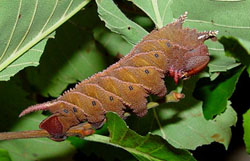 |
Ceratomia amyntor
DF/BW,
the Elm Sphinx or Four-horned Sphinx
Larvae feed on Elm (Ulmus), birch (Betula), basswood
(Tilia), and cherry (Prunus).
There are both green and brown forms. The four horns near
the head are diagnostic. |
Ceratomia amyntor, Saskatoon, October 5, 2008, Doug Freestone.
Ceratomia amyntor, Saskatoon, September 6, 2011, Betty Wotherspoon.
 |
Fraxinus, Ligustrum, Quercus, Crataegus and
Chionanthus virginicus are listed as hosts.
In the fifth instar, the spiracular ovals are decidedly red and the
anal horn is off-white to pinkish laterally.
|
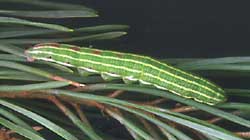
|
This caterpillar is also without the anal horn and feeds on pines.
The long stripes and reddish brown afford great camouflage.
|
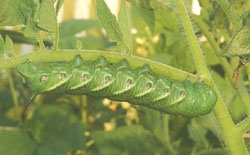 |
The caterpillars are called Tomato Hornworms and each has a black horn at the end of the abdomen.
Larvae feed on potato, tobacco, tomato, and other plants in the
nightshade family (Solanaceae).
|
 |
Sphinx chersis
WO/FR, the Northern Ash Sphinx or Great Ash
Sphinx:
The larvae are pale bluish green. The head has a pair of yellow
lateral bands meeting at the apex. The oblique, lateral stripes are
pale and bordered anteriorly with a darker green.
Larval hosts are ash, lilac, privet, cherry, and quaking aspen.
|
Sphinx chersis final instar, Lumsden Beach, August 11, 2011, Fiona Ramsay.
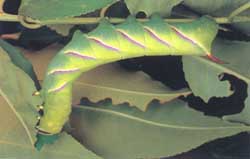 |
Sphinx drupiferarum
WO,
the Wild Cherry Sphinx: Sphinx drupiferarum larvae hide by day and feed primarily on
cherry, plum and apple at night.
Larvae have been found on Amelanchier nantuckensis in
Massachusetts and have been reared to pupation in Michigan on
Prunus serotina from eggs readily oviposited by a female.
|
 |
The upperside of the forewing ranges from brown with black borders
through brownish gray with paler borders to pale gray with no
borders. It is probably Sphinx poecila that
is present in Ontario. |
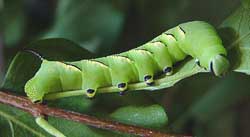 |
Sphinx kalmiae
WO, the Laurel Sphinx:
The lower forewings are predominantly brownish-yellow with a fairly
wide dark bar along the inner margin. At rest the wings hug the body,
giving the moth a long slender look. Anal horn is blue with extensive black markings in final instar.
|
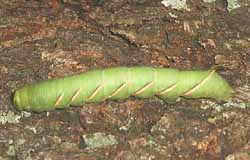 |
Sphinx luscitiosa
WO,
Canadian Sphinx or
Clemen's Sphinx.
Larval hosts are willow
(Salix), poplar (Populus), birch (Betula),
apple (Malus), ash (Fraxinus), waxmyrtle
(Morella), and northern bayberry.
|
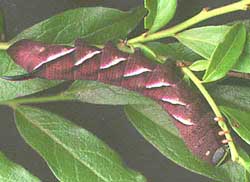 |
If you have blueberries in the woods, then you probably have the
Poecila Sphinx. There are both a green form and a purple form.
|
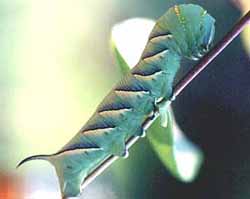 |
Larvae feed on the common snowberry (Symphoricarpos albus)
and on coralberry (S. orbiculatus). Note the two golden lines
of slightly raised bumps, one just behind the head, the other on the
thorax. |
Smerinthini Tribe:
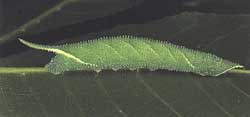 |
Amorpha juglandis larvae feed upon Walnut and butternut (Juglans),
hickory (Carya), alder (Alnus), beech (Fagus),
hazelnut (Corylus), and hop-hornbeam (Ostrya). questionable |
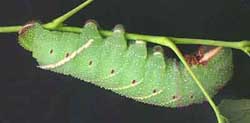 |
Pachysphinx modesta
WO,
the Modest Sphinx or Poplar Sphinx
Larvae feed on poplars and cottonwood.
The anal horn is very rudimentary in the final instar.
|
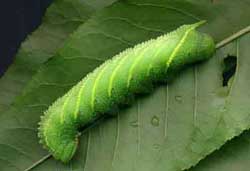 |
Larvae accept willows, birches, and cherries.
I have also found them in the wild on oak in eastern Canada.
generally more eastern species
|
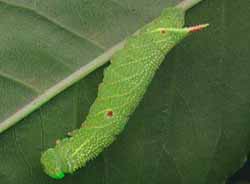 |
Wild cherry species are the favorites as larval foodplants, but eggs
will also be deposited on birches and other forest trees.
There are varying degrees in the amount of red markings along the sides.
|
 |
Smerinthus cerisyi
WO,
Cerisy's Sphinx;
Larvae greatly resemble modesta larvae, both being pale
green, with granular skin, pale lateral diagonal lines, faint red
spiracular circles, and very pale longitudinal lines running from the
head to more pronounced anal diagonal line.
Green heads are bounded dorsally with pale yellow
inverted "V".
|
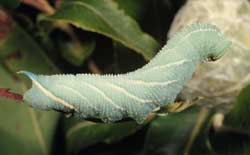 |
Larvae feed upon many forest trees including birches and cherries,
but are expecially fond of poplars and willows. Red markings on sides
vary greatly from specimen to specimen.
|
Macroglossinae subfamily
Dilophonotini Tribe:
See Hemaris comparison to help distinguish
the next three species.
 |
Hemaris diffinis
WO, the
Snowberry Clearwing or Bumblebee Moth:
Larval host plants include Snowberry (Symphoricarpos),
honeysuckle (Lonicera), Coralberry, viburnums, Blue Dogbane
(Apocynum) and dwarf bush honeysuckle (Diervilla lonicera).
Horn is black with a yellow base.
|
Hemaris diffinis fifth instar, Regina, July 26, 2011, courtesy of Tim Taylor.
 |
Hemaris gracilis
WO, the
Slender Clearwing or Graceful Clearwing
Larval foods are blueberries including low bush blueberry
(Vaccinium vacillans), and laurel (Kalmia), all in the
heath family (Ericaceae).
|
 |
Hemaris thysbe
WO, the Hummingbird Clearwing
There is also an orangey-pink prepupal form. The lateral line runs
from S1 to the blue horn.
Hemaris thysbe larvae feed on viburnum and related plants.
generally more eastern species
|
Philampelini tribe:
 |
Larvae feed upon Grape (Vitis), Virginia Creeper
(Parthenocissus quinquefolia) and other vines and ivies
(Ampelopsis).
Larvae occur in both a light (green) form and a darker (tan/brown)
form. Note six "segmented" oblique lines.
|
Eumorpha achemon, Estevan, Saskatchewan, September 10, 2010, Karen Edwards.
Macroglossini Tribe:
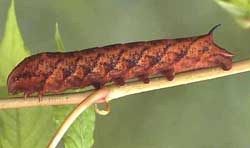 |
In additon to Virginia creeper larvae accept Grape (Vitis),
ampelopsis (Ampelopsis), and cayenne pepper (Capsicum).
Larvae are green until the final instar.
|
 |
Darapsa choerilus
WO, the Azalea Sphinx:
Larvae feed on Azalea and Viburnum and progress very rapidly. The
larva to the left on Viburnum cassinoides is getting ready to
pupate. Color change from green to light burgundy-brown indicates
pupation is imminent. |
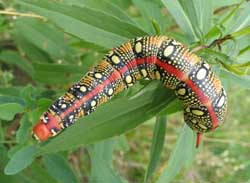 |
Hyles euphorbiae
MKM/DF, the Spurge Hawk Moth:
Young larvae are variously patterned with green, yellow, and
black; older larvae have a distinctive red, black, yellow, and white
color pattern. Mature larvae may approach 10 cm in length; when
disturbed, they regurgitate a slimy green liquid.
Larvae feed on leafy spurge.
|
Hyles euphorbiae, Swift Current, July 31, 2007, Marnie Kay-Macmillan
Hyles euphorbiae, Zehner (12 miles NE of Regina), Dave Fries
 |
Hyles gallii
WO, the Bedstraw Hawk Moth
or Gallium Sphinx:
This species is not reported in Chippewa, but it has been recorded in
eastern Wisconsin counties. I suspect it is present.
Larvae come in black and in brown forms (see bottom of page) and often feed on
Epilobium (fireweed).
|
 |
Hyles lineata
WO, the White-lined Sphinx
Larvae are highly varied and feed on a great diversity of plants
including willow weed (Epilobium), four o'clock (Mirabilis),
apple (Malus), evening primrose (Oenothera), elm
(Ulmus), grape (Vitis), tomato (Lycopersicon),
purslane (Portulaca), and Fuschia.
All larvae seem, however, to have the red/black swellings split by
dorso-lateral lines. |
 |
Proserpinus flavofasciata
WO, the Yellow-banded Day Sphinx.
Penultimate instar pale green with pair of pale,
dorsolateral lines running from head to base of short caudal horn.
Last instar: brown-black with numerous black dots; caudal horn
replaced by black button surrounded by white ring edged with black.
|
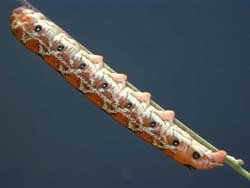 |
Newly-hatched caterpillars eat their eggshells. Larvae feed on
(Onagraceae) including evening primrose (Oenothera), gaura (Gaura),
and willow weed (Epilobium). Michael Van Buskirk has found them on
Guara biennis in Missouri.
|
|
|



